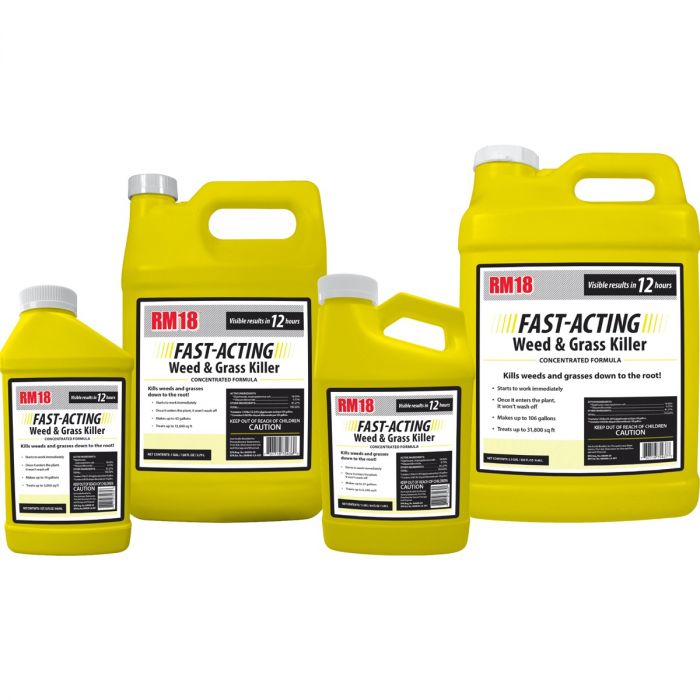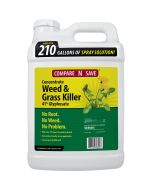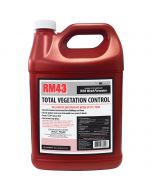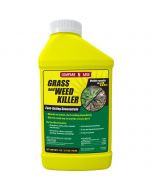Fast-Acting Weed and Grass Killer
Fast Results. Kills to the Root.
When you want fast results with minimal prep, RM18 is your total weed control solution for unwanted brush, broadleaf plants, and grass.
Ingredients
A combination of two herbicides, glyphosate and diquat, RM18 starts to kill weeds on contact, producing visible wilting within 12 hours.
Kudzu, wild blackberry, poison ivy, poison oak, crabgrass, and dandelions (and over 100 other plants) are no match for this product, which is rainfast in thirty minutes. There are no entry restrictions to sprayed areas for pets or people after the spray has dried.
When To Replant
- All ornamental flowers, trees and shrubs may be planted 1 day after application.
- Lawn grasses, herbs, vegetables, and fruits may be planted 3 days after application.
Where to use:
| Patios | Along fences | Walkways and gravel paths |
| For establishment of gardens | Driveways | To prep flower and garden beds** |
| Mulch beds | Lawn replacement |
** While RM18 can be used to clear an area for a garden or flowerbed, it SHOULD NOT BE USED for spot weed treatment after planting fruits and vegetables or damage will occur. Hand-pulling is always recommended for garden weeds.
When to use:
For best results apply on a warm, sunny day when wind is calm and weeds are actively growing. For easy to kill weeds such as small seedlings, use the lowest recommended rate (3 fl oz in 1 gallon of water). Use the maximum recommended rate for larger, harder-to-kill weeds (6 fl oz in 1 gallon of water).
How to use:
For General Weed Control
In a tank sprayer, mix 6 fl oz in 1 gallon of water. Use the mixture as a spot treatment or spray the mixture evenly over 300 sq ft. Spray the weeds or grasses you want to kill until thoroughly wet. If using as a spot treatment around desirable plants, shield wanted plants from spray drift. If wanted plants are contacted by spray solution rinse immediately with water or cut off treated area.
For Spot Control of Brush, Vines, and Weeds
Thoroughly and uniformly spray foliage of woody plants to cover all leaves thoroughly. For optimum performance:
- Mix 6 fluid ounces (12 tablespoons or ¾ cup) per gallon of water for every 300 square feet (not to exceed three applications at that rate per year)
- Apply to actively growing brush, vines and weeds.
- Woody brush and vines are controlled better in late summer and fall after fruit formation, at least four weeks before first killing frost.
- If woody vines and brush are mowed or cut, wait until full leaf formation before treatment.
- Do not cut or mow brush, vines or perennial weeds for two months following treatment to allow for the herbicide to be distributed within the plant.
- Dead poisonous plants like poison oak and poison ivy can still cause allergic reactions. Dispose of plants with rubber gloves and place in tightly sealed garbage bags.
- Additional treatments may be necessary for exceptionally hardy plants.
For Lawn Replacement or Patio Preparation
To kill a large area of unwanted lawn and weeds, mix 6 fluid ounces per gallon of water for every 300 square feet (not to exceed three applications at that rate per year).
- Skip one mowing before spraying to increase available surface area for spray contact.
- If replanting, soak soil and allow plants to dry before application, and then water area two or three days after application.
- Retreat areas that remain green after 7 days.
- Wait three days after application before raking, tiling, sodding, or seeding.
For Flowerbed and Garden Prep
For best results, soak soil (not leaves) with water before application and three days after spraying. Wait one to three days after last application before planting flowers, trees, and shrubs. Wait three days to plant vegetables, fruits, herbs, and grasses.
Precautions:
- Do not apply this product in a way that will make contact with people or pets, either directly or through drift. Only protected handlers may be in the area during application. For any requirements specific to your state or tribe, consult the agency responsible for pesticide regulation.
- Do not allow entry to treated areas until spray has dried thoroughly.
- Do not use on feed or food crops.
- Keep people and pets out of the area during application.
- Protect desirable plants around the spray area with plastic.
Active Ingredients:
| Glyphosate, isopropylamine salt | 18.00% |
| Diquat dibromide | 0.73% |
| Other Ingredients | 81.27% |
| Total | 100.00% |
Product Label:
Disclaimer:
It is a violation of Federal law to use this product in a manner inconsistent with its labeling. Read the entire label before each use. Use only according to label instructions.
See the complete label for specific use rates and detailed instructions.
Consult the Safety Data Sheet (SDS) for important safety information.




